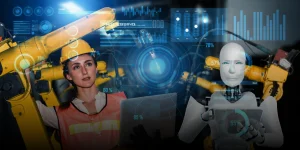March 27th, 2025
Category: ai agents,Artificial Intelligence
No Comments
Posted by: Team TA

AI agents are transforming industries by automating tasks, optimizing workflows, and improving decision-making. These intelligent systems leverage machine learning and natural language processing to analyze data, interact with users, and adapt to evolving situations. From serving as virtual project managers to handling intricate financial reconciliations, Artificial Intelligence agents streamline operations and augment human capabilities. These agents can potentially redefine innovation and productivity as businesses adopt AI-driven solutions. This blog explores what are AI agents, their examples, applications, types, and benefits.
According to MarketsandMarkets analysis, the market for AI agents is expected to expand rapidly, from $5.1 billion in 2024 to $47.1 billion by 2030.
What are AI agents?
AI agents are intelligent software systems that use artificial intelligence to complete tasks and achieve goals for users. They can think, plan, and learn from past experiences, allowing them to make decisions independently. These agents use AI models to analyze data, adapt to new situations, and determine when to access information or tools to complete a task efficiently. For example, a company used an AI agent to improve its marketing campaigns. What once needed six analysts per week was completed by one employee with AI in under an hour.
How Do They Work?
1.) Observation
AI agents observe their surroundings by gathering and processing data. They collect information from user inputs, system interactions, or external sensors. This continuous observation helps them understand the current situation and retain memory across different tasks. For example, in self-driving cars, sensors like LIDAR and cameras capture real-time data about traffic, obstacles, and road conditions.
2.) Planning
AI agents plan their actions by carefully analyzing the information they collect. Using machine learning and AI algorithms, they process data, identify patterns, and draw useful insights. They prioritize tasks, detect missing information, and use tools like web searches or APIs to fill knowledge gaps. For example, a recommendation system studies past user behavior to suggest personalized products or services, improving the user experience.
3.) Action and Learning
AI agents execute tasks by interacting with enterprise systems, delegating work to other AI agents, or directly assisting users. These actions can be digital, like processing transactions, or physical, like a robotic vacuum navigating a room. Over time, AI agents improve through learning, making them more efficient and adaptable in various applications.
Types of AI Agents
- Simple Reflex Agents
Simple reflex agents are the most basic type of AI agents. They make decisions based only on the current situation, following predefined rules without considering past experiences. These agents do not store memory or interact with other agents to gather missing information.
An example of a simple reflex agent would be an automatic thermostat that turns on and off the heating based on the current temperature. They are easy to design and efficient in controlled settings. However, their major limitation is that they cannot learn, adapt, or handle unexpected situations in complex environments.
- Model-Based Reflex Agents
Model-based reflex agents are more advanced than simple reflex agents because they maintain an internal model of their environment. This allows them to make better decisions in partially observable situations by considering both current perceptions and past experiences.
A robot vacuum cleaner, for instance, can detect obstacles like furniture and modify its course accordingly. Additionally, it keeps track of areas it has previously cleaned to prevent task duplication. These agents need more processing power to work effectively, but they are helpful in applications like industrial automation and GPS navigation.
- Goal-Based Agents
In addition to maintaining an internal model, goal-based agents strive toward a particular objective. They evaluate different actions based on how well they help achieve their objective. By using search and planning algorithms, these agents determine the best sequence of actions before executing them, making them more effective in decision-making.
A GPS navigation system, for example, evaluates several routes to arrive at the destination and suggests the quickest one. It modifies the plan if a faster route becomes available. Although these agents need sophisticated algorithms and a lot of processing power, they are helpful for robotic path planning and task scheduling.
- Utility-Based Agents
Utility-based agents make decisions by evaluating different outcomes and selecting the most beneficial one. These agents take efficiency, cost, and time into account to maximize overall satisfaction, in contrast to goal-based agents that only concentrate on achieving a goal. Each potential course of action is given a value using a utility function, and the action with the greatest benefit is selected.
For example, a GPS navigation system not only finds the shortest route but also considers fuel efficiency, traffic, and toll costs to determine the best option. These agents are widely used in financial trading and resource management but require complex calculations to function effectively.
- Learning Agents
Learning agents stand out because they improve over time by gaining knowledge from experience. Unlike other AI agents, they adapt to new situations by continuously updating their understanding of the environment. They use learning algorithms to refine their decision-making and enhance performance, making them effective in complex and unpredictable settings.
E-commerce recommendation systems, for instance, keep track of user preferences and modify product recommendations in response to previous transactions. The agent improves its accuracy with every new suggestion, guaranteeing more relevant outcomes. Despite their high degree of adaptability, these agents need a lot of data and processing power to learn.

Benefits of AI Agents
1.) Automation of Tasks
AI agents are transforming businesses by automating tasks, improving efficiency, and reducing costs. According to a McKinsey report, AI agents could automate 15% to 50% of business tasks by 2027. They handle repetitive work with accuracy, minimizing errors and freeing employees for higher-value tasks, leading to faster growth and smarter operations.
2.) Improved Efficiency
By automating complicated tasks and offering data-driven insights, AI agents increase productivity. Research indicates that by improving learning and decision-making, multi-agent frameworks perform better than single agents. They boost individual productivity, optimize marketing tactics, and assist businesses in streamlining operations. AI agents facilitate quicker, more intelligent decision-making by lowering manual labor, which eventually boosts efficiency across all industries.
3.) Better Communication
AI agents facilitate quick and effective interactions, which improves communication. Chatbots cut down on wait times by quickly responding to consumer inquiries. While AI-powered translation tools remove language barriers for smooth international communication, voice assistants process commands to help with tasks. This guarantees quicker reactions, more seamless teamwork, and effective international communication.
4.) Quality of Responses
They deliver high-quality responses by providing accurate, personalized, and comprehensive information. They achieve this by learning from past interactions, using external tools, and exchanging data with other AI agents. This improves user experience, enhances decision-making, and boosts productivity. From tailored recommendations to predictive assistance, AI agents create a more efficient and intuitive work environment.
5.) Simulation and Social Interaction
By simulating human-like relationships and behaviors, AI agents improve social interactions and simulations. They support training, research, and self-analysis by learning from real-world data to produce realistic interactions. AI simulations can replicate personalities with 85% accuracy, according to a Stanford and Google DeepMind study, making them useful resources for professional training and behavioral research.
Examples of AI Agents
1. HR Support and Employee Empowerment AI Agents
By automating the hiring, onboarding, and offboarding processes, AI agents enhance HR support. They set up interviews, review resumes, and provide resources to new employees. They manage paperwork and safeguard corporate information for offboarding.
AI agents are used in performance management to evaluate employee feedback, forecast attrition risks, and recommend engagement tactics. They guarantee accuracy and efficiency in HR operations by personalizing surveys, suggesting wellness initiatives, and streamlining leave and payroll administration.
2. AI Agents in Healthcare Operations
They improve data management and patient care coordination, which improves healthcare operations. They ensure smooth communication between primary care doctors and specialists by combining patient records from various providers. This reduces hospital admissions and allows better chronic disease management.
These agents also analyze complex medical data, optimizing workflows and speeding up claim approvals. By processing electronic health records (EHRs) and using predictive analytics, AI systems improve diagnostic accuracy, helping detect diseases early and supporting better medical decision-making.
3. Robotic Agents
Robotic agents in manufacturing maximize production time by accurately completing assembly tasks like welding and painting. Surgical robots help physicians carry out delicate procedures in the medical field, extending human capabilities while guaranteeing accuracy and security.
AI-driven robots in agriculture increase productivity by automating tasks like planting, harvesting, and field monitoring. From automated vacuum cleaners to wait staff in restaurants, service robots are also widely utilized to increase operational efficiency and convenience in daily tasks.
4. AI Agents for Customer Support
They enhance customer support by providing 24/7 assistance, handling multiple queries simultaneously, and reducing wait times. These agents personalize customer interactions by analyzing past behaviors and preferences, ensuring relevant recommendations. Additionally, they can identify complicated problems and, while preserving context, escalate them to human agents with ease.
Wrapping Up
AI agents are revolutionizing business operations by collaborating with humans to improve scalability, creativity, and efficiency. They free up workers for higher-value work by automating tasks and integrating them into workflows. As AI adoption grows, organizations must focus on responsible AI management, ensuring ethical use, privacy, and fairness in every aspect. Unlock new possibilities with AI agents and revolutionize your workflow.
Consult our experts at Travancore Analytics to explore tailored AI solutions for your business.